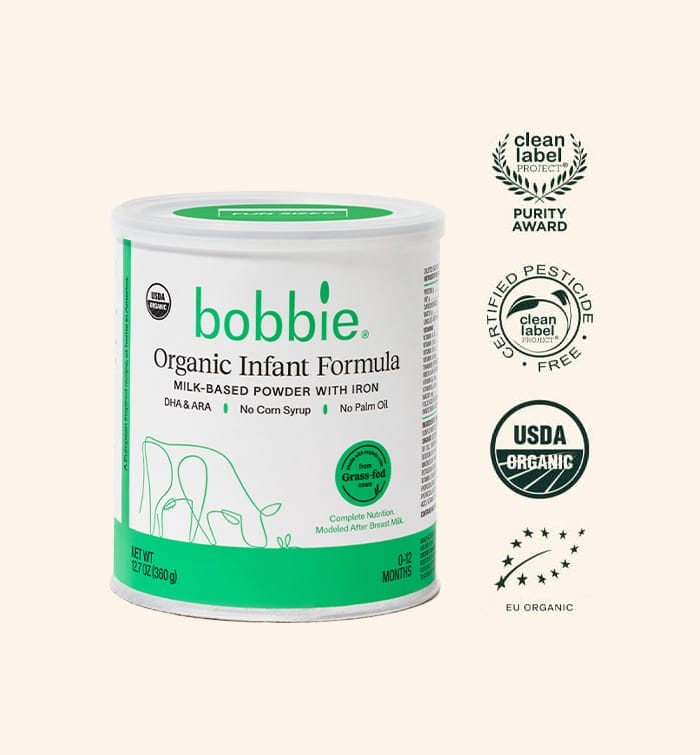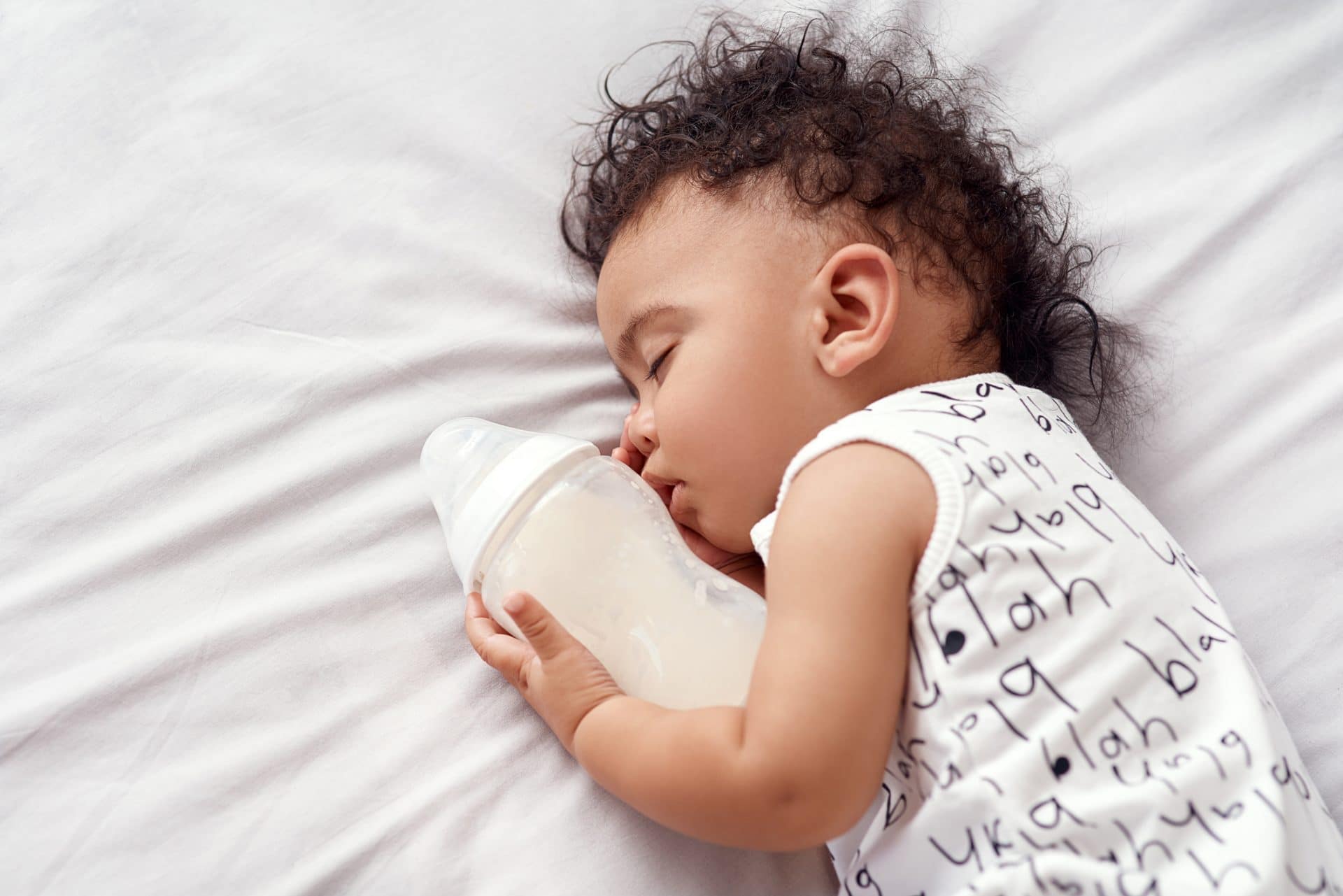We are proud to say that these posts are not sponsored. Our editorial team of Bobbie moms and writers personally select each featured product. If you buy something through our links, we may earn an affiliate commission, at no cost to you.
If you’ve been in the infant formula aisle of your local store lately, you know that there are an overwhelming number of options. Not only do formulas differ in their ingredient labels, but they also come in different forms. Some are jugs of liquid concentrate, some are small bottles of liquid and some are cans or containers of powder.
What’s the difference between liquid and powder formula? Is one better than the other? How should you choose between them? We will help you break it down to make the most informed choice when it comes to choosing baby formula.
- The different forms of infant formula
- What is powder baby formula?
- What is liquid concentrate baby formula?
- What is ready to feed baby formula?
- Key comparisons between types of baby formula
- Cost comparisons of baby formula types
- Convenience comparisons of baby formula types
- How to measure and mix different types of baby formula
- What’s the best formula for your baby?
All US baby formulas are FDA regulated
First things first- it’s important to know that all US made infant formula is regulated by the Food and Drug Administration (FDA).1 This means any formula you choose has all of the nutrients, vitamins, and minerals required by FDA for infant growth and nutrition.
The different forms of infant formula:
What is powder baby formula?
Powdered formula comes in a container with its own measuring scoop. It’s easy to find and comes in many different varieties- milk-based, soy-based, hypoallergenic, organic and the list goes on.2

Shop Bobbie Organic Infant Formula
Bobbie Organic Infant Formula is a USDA Organic, EU-style infant formula that meets all FDA requirements. It is a complete nutrition milk-based powder modeled after breast milk and is easy on tummies. It is non-GMO and doesn't have corn syrup, palm oil, or maltodextrin. Learn more about Bobbie.
What is liquid concentrate baby formula?
Liquid concentrate formula works similarly to powdered formula in terms of preparation. In this case, you are just mixing a liquid concentrate with water instead of powder.2
What is ready to feed baby formula?
Ready-to-feed formula is, well, ready to feed. No mixing with water, just open and serve.2 This is the formula type given at the hospital since ready to feed is sterile. You can stick with ready to feed once you are home from the hospital, although you can switch formula types and use powder as a less expensive option.
Key comparisons between types of baby formula
While any form of US baby formula meets FDA standards for nutritional content, there are still differences between the forms that might make one a better choice for your baby than another. Let’s take a closer look.
Cost comparisons of baby formula types
As you can imagine, ready-to-feed formula is generally the most expensive form of infant formula. So, while there’s no mixing or preparation involved, you will pay extra to avoid these tasks.
Powdered formula is usually the least expensive form of infant formula and liquid concentrate falls somewhere in the middle.2
Convenience comparisons of baby formula types
Since ready-to-feed formula doesn’t need any water added, it’s definitely the most convenient form of infant formula- just open and feed! This makes it a good option for traveling or leaving with a grandparent or other caregiver to avoid the need for mixing (and any room for error).3
Liquid concentrate and powdered formulas need to be mixed with water, so this may make them less convenient in certain circumstances like traveling or in the middle of the night, but these could still be a great choice for day to day feedings.
How to measure and mix different types of baby formula
Because liquid concentrate and powdered formulas need to be mixed with water, this means there is measuring of both the water and the powder or concentrate involved. For most powdered formulas the ratio is 1 scoop to 2 oz of water and for most liquid concentrates it’s 1 oz of water to 1 oz of liquid concentrate, but you should always read the directions on the container of formula you are using to be sure.
Anytime there is measuring involved in baby formula preparation there is room for error. Errors in measuring and mixing formula that happen over and over again can lead to too much or too little weight gain for babies or more serious medical problems. This is why it might be a good idea to mix bottles ahead of time for less experienced caregivers.
Are all types of baby formula sterile?
Both ready-to-feed and liquid concentrate are considered commercially sterile. Because of this, they may be the preferred options for premature babies or those with medical issues. Be sure to talk with your baby’s healthcare provider if you have questions about this.3,4
How to save and store baby formula
No matter which form of formula you choose for your baby, any leftover prepared formula in a bottle your baby drank from should be thrown out. This is because bacteria from your baby’s mouth can get in the bottle and cause contamination.5
But when it comes to storing prepared bottles of formula that haven’t already been offered to your baby, there are differences between how long you can hold onto bottles made from powdered and liquid formulas.
Although it’s best to prepare a bottle right before you give it, this isn’t always possible. Any prepared bottles, pitchers or open containers in the case of ready-to-feed formula should be stored in the fridge within 1 hour or they need to be thrown out.
Unopened containers of ready-to-feed formula can be stored at room temperature.
Bottles made from powdered formula can be stored for up to 24 hours in the fridge and those made from liquid concentrate or open containers of ready-to-feed formula can be refrigerated for up to 48 hours.2,6
Environmental effect of baby formulas
If you are concerned about the environmental effect of formula packaging, powdered formula generally offers the lowest environmental impact. This is because it comes in much less packaging than liquid forms of infant formula.4
Adjusting calories per serving for baby formula
Although most babies require the standard amount of calories in infant formula (about 20 calories/oz), there are some babies, such as those who were born prematurely or have certain medical conditions, that require higher calorie formula. Sometimes healthcare providers recommend concentrating standard formula to make it higher in calories for these babies.3
Concentrating formula involves using less water than called for when mixing to increase calories. Since this is only possible for formulas that are mixed with water, it can only be done with powdered and liquid concentrate formulas.
If you think your baby may need a higher calorie formula be sure to talk with their healthcare provider. You should only mix formula as instructed on the container unless a healthcare provider tells you to do otherwise.
So what’s the best formula for your baby?
As you can see, there are lots of similarities and differences between liquid and powder formula options. While they all meet nutritional standards, differences in cost, preparation and storage may mean that one form works better for you and your baby than another.
Make sure to consider all of your baby formula options, the pros and cons and discuss any questions you have with your baby’s healthcare provider. Remember, the best infant formula is the one that works best for you and your baby!

Shop Bobbie Organic Infant Formula
Bobbie Organic Infant Formula is a USDA Organic, EU-style infant formula that meets all FDA requirements. It is a complete nutrition milk-based powder modeled after breast milk and is easy on tummies. It is non-GMO and doesn't have corn syrup, palm oil, or maltodextrin. Learn more about Bobbie.
Sources:
1- Questions & answers for consumers concerning infant formula | Food and Drug Administration
2- Forms of baby formula: Powder, concentrate, & ready-to-feed | American Academy of Pediatrics
3- What’s in a bottle? A review of infant formulas | Nutrition in Clinical Practice
4- How long does baby formula last? | Forbes
5- Infant formula preparation and storage | Centers for Disease Control and Prevention
6- Feeding your infant: how to prepare and store baby formula | Cleveland Clinic

